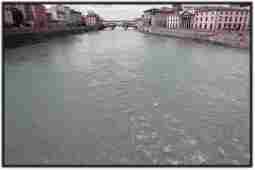Is it true that the Arno is ailing?
When we studied it a few years ago examining the microalgae indicative of pollution we observed that whereas upstream from Florence the river still had good self-purifying capacities there was a clear deterioration in the stretch immediately downstream. Unfortunately, the Arno like all the rivers which receive excess waste, either barely treated or completely untreated, isn't capable of transforming the excess organic material and can undergo eutrophication (an enrichment of the quantity of nutrients).
Because of the strong reduction in the flow of the river in the summer season these phenomena are even more noticeable and, on various occasions, there have been very serious consequences: algae bloom, asphyxia and dying fish.

Arno river in Florence, Italy
Are there any species of poisonous algae?
Although there is no specific research on the subject some potentially toxic species have been observed. The phenomenon, which was mild and confined to the months of August and September, occurred in areas of the river which are barely affected by currents such as the Penna area and the weirs in Florence.
Where does pollution in the Arno begin?
In a limited, but more or less progressive fashion, in the first stretch. The greatest and most worrying pollution begins in the stretch through Florence with the contribution of the polluting waste from the city and immediately after the first tributaries (Bisenzio and Ombrone) right to the river mouth.
What are the remedies for nursing the Arno back to health?
There isn't one simple solution for such a complex problem which requires an enormous amount of scientific expertise (hydrological, geological, chemical, etc), not to mention political and legislative decisions. Certainly, any intervention aimed at reducing the organic and mineral polluting waste (especially nitrogen and phosphorus) would be a good start. In practice, working purification plants are what is needed.
